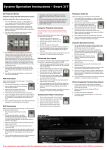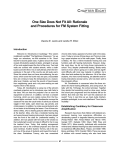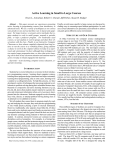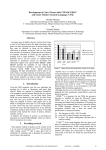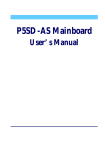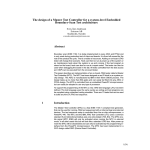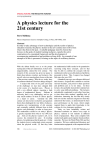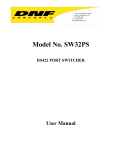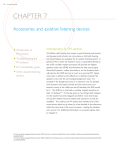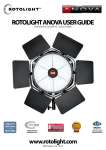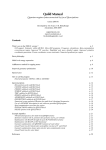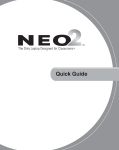Download Utilizing Wireless Polling Devices to Enhance Classroom Participation
Transcript
Utilizing Wireless Polling Devices to Enhance Classroom Participation Cathy W. Hall Department of Psychology, East Carolina University Greenville, North Carolina, 25848, USA and William W. Swart Department of Decision Sciences, East Carolina University Greenville, North Carolina, 25848, USA ABSTRACT Actively engaging students in learning processes, especially as class sizes increase, has become a major challenge for many in education. While technological advances have begun to provide viable options, it can be a daunting task to choose among the technology available that will serve one’s specific needs. The first part of this paper discusses some of the options that allow for more active learning, discussion of faculty/student factors in adoption considerations, and a focus on wireless polling devices (WPD) in particular. The second section discusses data obtained from student opinion surveys on the use of WPDs in undergraduate classrooms and assessment of WPD technology on student learning via course grades. Keywords: Wireless Polling Devices, Interactive Learning, Active Participation via Technology. INTRODUCTION Higher education faces many challenges today including keeping up-to-date with technological advances amid budgetary constraints. Serim [1] notes that schools as well as instructors are stretched almost to the breaking point by the demands of society, and this is probably felt the most dramatically in the classroom setting. At the same time, technological advances have presented options for becoming more effective in the way the way we teach. In larger classes it becomes more difficult to ascertain if students have a working knowledge of material covered or if more time needs to be spent on a particular topic. The idea of “just-in-time” teaching as proposed by Novak et al. focuses in an interactive-engagement approach that allows ongoing assessment of student understanding and is supported through the use of technology [2]. While technological advances have begun to provide options to meet some of these demands in the classroom setting, it is often necessary to choose among those options very carefully and to determine how the technology will fit with learning objectives [3]. It is easy to become overwhelmed by the “bells and whistles” of technology, but it is important to remember that learning is the key objective not technology. How then does a faculty member/institution balance constraints (i.e., time, money, physical resources) with advances in technology? One of the objectives of this paper is to provide a way to begin evaluating the option of using WPDs based on their particular needs, a way of assessing student attitude toward technology in the classroom, and questions to take back to their perspective institutions. The second part of the paper looks at 36 specific data on the WPD system by the presenters. Two courses were chosen for this purpose. One course was a social science course in psychology and the second course was a business course in operations management. A good rule of thumb for many in higher education might be a statement by Cubero as cited in Novak et al. [2]: “As you enter a classroom ask yourself this question. If there were no students in the room, could I do what I am planning to do? If your answer to the question is yes, don’t do it.” Learning should be an interactive process between the instructor and students as much as possible. WPDs allow for this active learning by inviting class participation, enhancing lectures, engaging all students, and facilitating concept checks and quizzing students over material that has been covered. WPDs also allow instructors to assess whether or not students have grasped information and it is time to move forward, or if more time needs to be spent on certain concepts. The questions posed in this research study were: 1) does using WPDs improve students’ perceptions of active classroom participation, and 2) does the use of WPDs impact students’ academic performance? The analysis of the data collected for this study resulted in an affirmative response to both questions. Thus, we begin by considering some of the factors that should be taken into account when selecting a particular WPD option. SELECTING THE TECHNOLOGY Evaluating technology can be a difficult task and should be done before investing time, money and student involvement rather than after the fact. We propose ten factors that are summarized below as selection criteria for a WPD system: Type of technology: WPD systems are based on infrared (IR), radio frequency (RF), or Wireless/WiFi that use a recognized wireless standard such as the 802.11b/g wireless networks found on many campuses. Although least expensive and most prevalent, there are disadvantages to the use of IR because it requires a line of sight path for communication – something which is hard to achieve in large classroom settings. RF technology overcomes that obstacle at a price. Wireless/WiFi is the most flexible technology, but it requires the student to have access to a wireless PDA or a wireless laptop or notebook PC making its prohibitive to many. Cost: A WPD consists of the student response system (SRS), or “clicker”, and the receivers that serve as the interface to a computer, and the software. Typically, students are burdened with the costs of the SRS that can be just the cost of the device, SYSTEMICS, CYBERNETICS AND INFORMATICS VOLUME 5 - NUMBER 3 ISSN: 1690-4524 or the cost of the device plus registration fee imposed by a vendor to provide necessary access to a web site and services. As big as this cost may appear to a student, it is minimal when compared to the cost of installation, administration and maintenance that is borne by the university. Quality: Students often carry their clickers in their backpacks that are frequently tossed around. Unless a campus has dedicated rooms for this technology, the receivers and connectors are often carried by faculty that try to find an appropriate place for them in their classroom, in particular if they are using an IR technology which requires line of sight path for communication with students. Dropping receivers is a usual consequence of this process. In other words, the WPD receive rough treatment and consequently must be rugged and of high quality. Similarly, the end result of using these devices in the classroom is a student grade. Software malfunctions and “bugs” are not tolerated for very long in a classroom environment. help. The most desirable scenario is an interactive computer based training system to accompany the user guide and video. Vendor customer support/responsiveness: There will be questions which are not covered in the training materials or technical problems which are not anticipated. If the institution has developed a campus wide standard for WPDs then local support is available. Otherwise, the vendor is the source of support. This may be e via a web page that contains FAQ’s and an e-mail interface to handle other questions. Preferably, there also will be technical support available via telephone. It is possible that questions arise regarding the interface between a publisher’s instructor resources. This can lead to the “not my problem” syndrome where the WPD vendor will point the finger to the publisher and the publisher to the vendor. Thus, an integrated customer support capability that can resolve the problem regardless of the cause is most desirable. Compatibility with Course Management Systems: Some WPD providers offer software compatibility with course management systems such as Blackboard or WebCT so that their capabilities can be integrated with those provided by the course management system. At the same time, some WPD providers provide access to their own course management system via a web interface. Functionality: The key functions of a WPD system include question entry, question type, confidentiality, and record keeping. Question entry options can range from manual entry to full compatibility with Power Point, publisher’s question banks and test generation software such as TestGen. The type of questions that a WPD can handle can include multiple choice, true/false, single numerical answer, single text answer, and open ended. Confidentiality options can include choices between using a students name, a student ID number, or no identifier at all. The record keeping options can range from proprietary stand-alone software to being compatible with a course management system such as Blackboard or WebCT to the ability to import/export grade book information through coma delimited spreadsheets or data base files. Compatibility with and among publisher instructor resources: Many publishers have formed partnerships with WPD providers that provide substantial student discounts when the SRS is “bundled” with the textbook. However, that does not necessarily mean that there is software compatibility that allows the publisher’s question banks and test generation to interface with the WPD software. For example, the text materials for the operations management course included among the instructor resources a set of questions specifically designed to be used in conjunction with WPDs [4]. While some provide for Powerpoint slides to be directly converted to appropriate WPD questions, others do not allow questions from question banks or files from a system such as TestGen to be directly converted to a WPD format. In addition to the above selection criteria, there are other basic questions to ask that focus on the intended use of the technology. These questions include: 1) does the technology match the curriculum? 2) is it accurate and current? 3) does it contain clear and concise language? 4) will it arouse motivation and maintain interest? 5) does it provide for learner motivation? 6) is it of good technical quality? 7) is there evidence of effectiveness? 8) Is it free from objective bias and advertising? 9) is a user guide or other documents included? [5]. Beyond the above, ask what the technology will allow you to do that you are currently not accomplishing, and how the technology will aid in more efficient and effective student feedback and participation [6]. Appendix A presents a checklist of the above noted criteria. Campus Standards for WPD’s: WPDs, generally speaking, are not compatible with each other. Thus, as a result of the partnerships that exist between some publishers and some WPD providers, it is conceivable that students have to purchase different WPDs for different classes which may not be practical or cost effective. To avoid this situation, many institutions are or have considered the feasibility of establishing a campus wide standard for WPDs. Given the current state of the technology, such a standard will result higher SRS cost to students when the discounted SRS device bundled with a particular textbook is not compatible with the standard. USING THE TECHNOLOGY Scalability: Infrared based WPD’s often work well in small classrooms but this performance deteriorates when placed in a larger classroom requiring the purchase of RF or wireless/WiFi based technologies at higher costs. Training: As with most technology, using a WPD system is relatively easy once you know how. However, what it takes to get to that point is directly associated with the user friendliness of the training materials that are available. The availability of a user manual is a start, but a video on a DVD or web site can be ISSN: 1690-4524 This part of the paper looked at student perceptions of technology as well as academic performance using WPDs. Student surveys were obtained with regard to classroom participation and perceptions of technological use in the classroom for an upper level course in psychology and an upper level course in operations management in business. The survey asked students to respond to a series of questions using a 4-point Likert scale with 1 being the lowest rating and 4 the highest in regard to their perceptions of technology in the classroom. Student opinion survey data were collected across semesters when WPDs were (n=90) and were not (n=122) used for operations management course and upper level psychology course. In addition to student opinion surveys, academic performance as measured by test scores on a standard exam were collected across three semesters in the psychology course. SYSTEMICS, CYBERNETICS AND INFORMATICS VOLUME 5 - NUMBER 3 37 The material covered in the psychology course was consistent across the three semesters and the same exam was used to measure student performance. The variation across semesters was the way in which the material was presented. Three variations in presentation were assessed and they were: 1) use of WPD to respond to focus questions developed on the material covered (n=56); 2) only the focus questions on the material covered were used and students did not use the WPD (n=47); and 3) class lecture format without the use of focus questions or WPD (n=52). RESULTS A series of ANOVAs indicated significant differences in students’ ratings of the class as a whole. Those students who were active learners via WPD indicated significantly more positive responses across the following areas: feeling comfortable participating in class, the effectiveness of questions asked in class, the student’s likelihood of asking questions in class, feeling that they were active participants in class, and being able to focus attention on the material being covered. Overall results are presented in Table 1 and 2. Table 1 Analysis of Variance and Means of Questions for WPD and non-WPD Classes (n=212) ___________________________________________________ Mean Question Square F p _____________________________________________ 1. Comfort in participating 2. Relevance of focus questions 3. Likelihood of asking questions in class 4. How active a participant 5. Ease in focusing attention 8. Willingness to pay extra for technology in class 13.09 10.09 23.02 22.75 <.01 <.01 8.86 29.42 2.41 11.53 46.31 1.39 <.01 <.01 ns 73.62 49.69 <.01 Questions 6 & 7 were specific to WPD classes only and means are given in relation to the 4-point scale 6. Interest taking another class that uses technology X = 2.93 7. Comfort in using technology X = 3.43 ___________________________________________________ An ANOVA was computed with class format (WPD & focus questions, focus questions only, and neither WPD or focus questions) as the independent variable and scores from exam one as dependent variable. Results indicated a significant effect, F(2, 152) = 3.13, p = .04, ŋ2 = .04. Means and standard deviations for exam scores for each group were as follows: 1) WPD and focus question 81.61 (8.76), 2) focus question only = 78.06 (9.24), and 3) neither WPD nor focus question = 77.27 (10.71). Follow-up tests of least significant difference indicated there was a significant difference between class format one and three but not between one and two or two and three. The use of WPDs to elicit interactive classroom participation to focus questions resulted in higher exam scores than when neither WPD nor focus questions were used. 38 Table 2 Ratings, Means and Standard Deviations on Questions for WPD Classes Only (4-point scale) ___________________________________________________ Questions 4 Ratings 3 2 1 X SD _______________________________________ 1. I was satisfied with the technology used in the class. 56.1% 36.8% 7.0% 3.49 0.63 2. This course used classroom technology very effectively. 50.9% 47.4% 1.8% 3.47 0.60 3. I would be likely to take another course that uses this type of technology. 38.6% 52.6% 8.8% 3.30 0.57 4. In this class, the technology helped to increase my class participation. 53.6% 42.9% 3.6% 3.50 0.57 5. In this class, the technology helped me earn a higher grade. 33.9% 46.4% 19.6% 3.14 0.72 _________________________________________________________ DISCUSSION Technology has the capability to enhance the learning process of students, but it is not always an easy task to determine what type of technology will be the most efficient and effective [7]. A good fit among university, department, faculty, and students is needed in order to insure the success of implementation. This fit cannot be done without spending time assessing the role technology is expected to play and how it will enhance current teaching methods. If a good fit is not found and technology is adopted that does not meet the expectations and needs of the users, it may be very difficult to get potential consumers to reinvest in technology with respect to time and monetary commitments in the future. Planning in advance can help alleviate potential problems. Research from the current study supports the benefits of technology, specifically WPD technology, in student perceptions of benefits as well as actual benefits with regard to academic success. The WPD system allows active participation in the learning process. Instead of just one or two students answering questions, the WPD provides a means for every student to respond and to see how individual responses correspond to overall class response. The ability to be able to modify teaching methods in order to help students develop their own personal knowledge base has been cited as an effective component of the learning process [3]. WPD provides the instructor with immediate feedback of student comprehension and allows for the modification of teaching methods in a timely manner. Costs in terms of both time and money are reasonable, and there is also ease in portability from one classroom to another. In summary, technology has the capability of enriching the learning environment by helping all students become active participants. It can also provide immediate feedback to both the student and instructor and allow for “just-in-time” teaching measures to be implemented. Instructors are also able to choose from options that offer specifically designed packages that accompany texts [4] or they may choose to develop their own SYSTEMICS, CYBERNETICS AND INFORMATICS VOLUME 5 - NUMBER 3 ISSN: 1690-4524 material. There are many options available. While there are many advantages, there are pitfalls as well. Technology can enhance learning, but it is not the panacea that some perceive it to be. There needs to be planning for efficient and effective use in conjunction with learning objectives. REFERENCES [1] Serim, F. Information technology for learning: No school left behind. Fayetteville, NY: Big6 Associates, 2003. [2] Novak, G. M., Patterson, E. T., Gavrin, A. D., Christian, W. Just-in-time teaching: Blending active learning with web technology. Upper Saddle River, NJ: Prentice-Hall, 1999. [3] Rogers, P. L. Teacher-designers: How teachers use instructional design in real classrooms. in P. L. Rogers (Ed.) Designing for technology-enhanced learning (pp. 1-18). London, England: Idea Group Publishing, 2002, pp. 1-18. ISSN: 1690-4524 [4] Swart, W. PRS Questions in Power Point Format to Accompany Principles of Operations Management (Heizer, J and render B.) Pearson Prentice Hall, 2006. [5] Heinich, R., Molenda, M., Russell, J. D., & Smaldino, S. E. Instructional media and technologies for learning (7th ed.). Upper Saddle River, NJ: Merrill Prentice-Hall, 2002. [6] Hall, C. W. CPS: Increasing classroom participation via technology. National Social Science Journal, 26(1), 49-56. [7] Donaldson, J. A. Education, learning, and technology. In P. L. Rogers (Ed.) Designing Instruction for Technology -Enhanced Learning. London, England. Idea Group Publishing, 2002, pp. 19-54. SYSTEMICS, CYBERNETICS AND INFORMATICS VOLUME 5 - NUMBER 3 39 Appendix A Selection Criteria Spread Sheet OPTION 1 OPTION 2 OPTION 3 OPTION 4 CRITERIA I. Cost Student Clicker Registration Fee II. Type of Technology Infrared (IR) Radio Freq (RF) Wireless/WiFi III. Quality Hardware Clicker Receiver Software IV. Scalability Small class only Small and medium classes Small to large classes V. Compatibility Course Management Systems Blackboard WebCT Other VI. Compatibility with Instructor Resources Power Points Solution Manuals Question Banks TESTGEN Other VII. Campus Standard None CPS PRS Other VIII. Training User guide Training Video Interactive computerbased training IX. Customer Support Web site Technical support phone Integrated support with textbook publisher X. Functionaity Entering Questions Manually Power Point interface Power Point & textbook question bank Power Point & TestGen Type of Questions Multiple choice True/False Single numerical answer 40 SYSTEMICS, CYBERNETICS AND INFORMATICS VOLUME 5 - NUMBER 3 ISSN: 1690-4524 Single numerical & text answer Open-ended Confidentiality Use student ID Option no identifier Grade Book Integrated w software Ability to import/export ISSN: 1690-4524 SYSTEMICS, CYBERNETICS AND INFORMATICS VOLUME 5 - NUMBER 3 41








